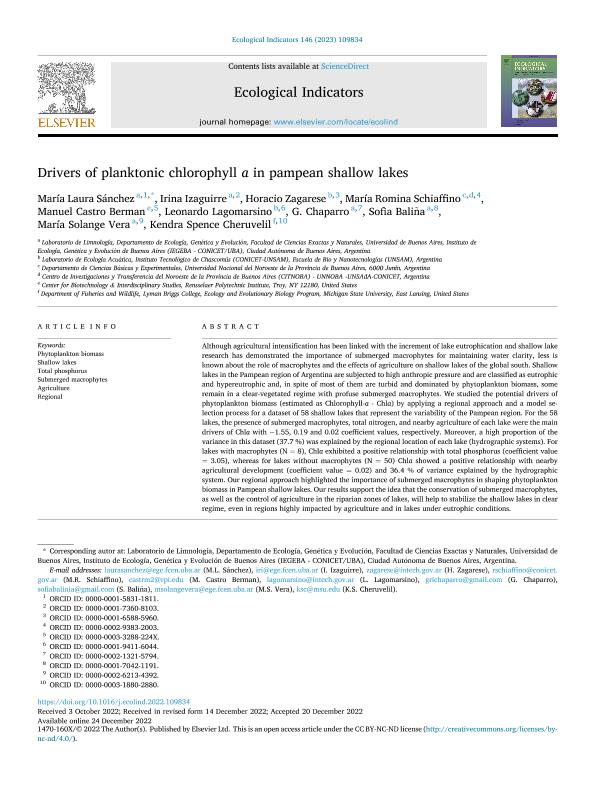Artículo
Drivers of planktonic chlorophyll a in pampean shallow lakes
Sánchez, María Laura ; Izaguirre, Irina
; Izaguirre, Irina ; Zagarese, Horacio Ernesto
; Zagarese, Horacio Ernesto ; Schiaffino, María Romina
; Schiaffino, María Romina ; Castro Berman, Manuel
; Castro Berman, Manuel ; Lagomarsino, Leonardo
; Lagomarsino, Leonardo ; Chaparro, Griselda Noemí
; Chaparro, Griselda Noemí ; Baliña, Sofía
; Baliña, Sofía ; Vera, Maria Solange
; Vera, Maria Solange ; Cheruvelil, Kendra Spence
; Cheruvelil, Kendra Spence
 ; Izaguirre, Irina
; Izaguirre, Irina ; Zagarese, Horacio Ernesto
; Zagarese, Horacio Ernesto ; Schiaffino, María Romina
; Schiaffino, María Romina ; Castro Berman, Manuel
; Castro Berman, Manuel ; Lagomarsino, Leonardo
; Lagomarsino, Leonardo ; Chaparro, Griselda Noemí
; Chaparro, Griselda Noemí ; Baliña, Sofía
; Baliña, Sofía ; Vera, Maria Solange
; Vera, Maria Solange ; Cheruvelil, Kendra Spence
; Cheruvelil, Kendra Spence
Fecha de publicación:
02/2023
Editorial:
Elsevier Science
Revista:
Ecological Indicators
ISSN:
1470-160X
Idioma:
Inglés
Tipo de recurso:
Artículo publicado
Clasificación temática:
Resumen
Although agricultural intensification has been linked with the increment of lake eutrophication and shallow lake research has demonstrated the importance of submerged macrophytes for maintaining water clarity, less is known about the role of macrophytes and the effects of agriculture on shallow lakes of the global south. Shallow lakes in the Pampean region of Argentina are subjected to high anthropic pressure and are classified as eutrophic and hypereutrophic and, in spite of most of them are turbid and dominated by phytoplankton biomass, some remain in a clear-vegetated regime with profuse submerged macrophytes. We studied the potential drivers of phytoplankton biomass (estimated as Chlorophyll-a - Chla) by applying a regional approach and a model selection process for a dataset of 58 shallow lakes that represent the variability of the Pampean region. For the 58 lakes, the presence of submerged macrophytes, total nitrogen, and nearby agriculture of each lake were the main drivers of Chla with −1.55, 0.19 and 0.02 coefficient values, respectively. Moreover, a high proportion of the variance in this dataset (37.7 %) was explained by the regional location of each lake (hydrographic systems). For lakes with macrophytes (N = 8), Chla exhibited a positive relationship with total phosphorus (coefficient value = 3.05), whereas for lakes without macrophytes (N = 50) Chla showed a positive relationship with nearby agricultural development (coefficient value = 0.02) and 36.4 % of variance explained by the hydrographic system. Our regional approach highlighted the importance of submerged macrophytes in shaping phytoplankton biomass in Pampean shallow lakes. Our results support the idea that the conservation of submerged macrophytes, as well as the control of agriculture in the riparian zones of lakes, will help to stabilize the shallow lakes in clear regime, even in regions highly impacted by agriculture and in lakes under eutrophic conditions.
Archivos asociados
Licencia
Identificadores
Colecciones
Articulos(CCT - LA PLATA)
Articulos de CTRO.CIENTIFICO TECNOL.CONICET - LA PLATA
Articulos de CTRO.CIENTIFICO TECNOL.CONICET - LA PLATA
Articulos(IEGEBA)
Articulos de INSTITUTO DE ECOLOGIA, GENETICA Y EVOLUCION DE BS. AS
Articulos de INSTITUTO DE ECOLOGIA, GENETICA Y EVOLUCION DE BS. AS
Articulos(IIB-INTECH)
Articulos de INST.DE INVEST.BIOTECNOLOGICAS - INSTITUTO TECNOLOGICO CHASCOMUS
Articulos de INST.DE INVEST.BIOTECNOLOGICAS - INSTITUTO TECNOLOGICO CHASCOMUS
Citación
Sánchez, María Laura; Izaguirre, Irina; Zagarese, Horacio Ernesto; Schiaffino, María Romina; Castro Berman, Manuel; et al.; Drivers of planktonic chlorophyll a in pampean shallow lakes; Elsevier Science; Ecological Indicators; 146; 109834; 2-2023; 1-11
Compartir
Altmétricas



